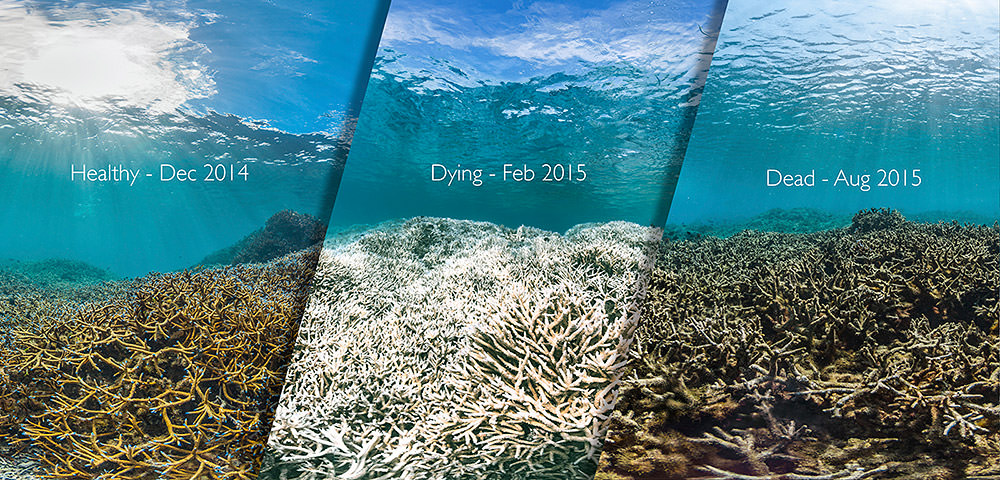- Home
- Critical Decade
- HI Climate Action
- HI Commission
- HI Resources
- HI Equity
- HI Events
Ocean Acidification
Ocean Acidification: How It’s Changing Our Coral Reef Communities
Our oceans are facing a silent crisis—ocean acidification (OA), a direct result of the carbon dioxide (CO₂) we release into the atmosphere. In fact, nearly 25% of the CO₂ produced by burning fossil fuels for energy is absorbed by the ocean. (Source: NOAA Ocean Acidification Program)
When carbon dioxide dissolves in seawater, it triggers a series of chemical reactions that lower the pH of the water, making it more acidic. This shift in ocean chemistry has serious consequences for marine life—especially for organisms that rely on calcium carbonate to form their shells and skeletons, such as corals, oysters, clams, and certain plankton.
As the ocean becomes more acidic, it becomes harder for corals to grow and maintain their structures. Over time, coral reefs can begin to die and crumble, drastically altering the underwater environment. This loss of coral habitat has a ripple effect on reef fish and other marine species that depend on coral reefs for shelter, food, and breeding grounds. Fewer fish means less biodiversity and a reduced food supply for coastal communities.
But the impact doesn’t stop beneath the waves. Coral reefs act as natural barriers, absorbing the energy of waves and storms. When reefs weaken or disappear due to acidification, coastal regions become more vulnerable to erosion, property damage, and flooding. This increases the risk to homes, infrastructure, and the lives of people living near the shore.
Beyond their ecological and protective value, coral reefs hold deep cultural, spiritual, and economic significance for many coastal and island communities. They provide food security, support tourism and recreational industries, and are intertwined with traditional practices and beliefs. Healthy reefs mean healthy communities.
Monitoring Methods and State Planning
Monitoring ocean acidification (OA) provides scientists with valuable insights into how the ocean is responding to climate change—and what that means for marine ecosystems, coastal communities, and local economies. By integrating OA and coastal acidification monitoring into marine management strategies, governments can strengthen climate preparedness and boost local understanding of environmental change.
To fully grasp the effects of climate change on ocean chemistry, it’s essential to track four key chemical parameters. Learn more about them here.
Hawai‘i is affected by both global OA and localized coastal acidification caused by land-based pollution such as runoff and wastewater. To address this, the state developed an Ocean Acidification Action Plan outlining goals from 2021–2031. The plan aims to increase scientific understanding through monitoring at sites like Station ALOHA and the Hawai‘i Ocean Time-series, support research on native species and local geographic impacts, and conduct vulnerability assessments. Mitigation efforts focus on reducing CO₂ emissions and land-based pollution at global, national, and local levels. The plan also emphasizes building resilience in coastal communities and ecosystems, promoting adaptive management, and improving public understanding through education and engagement. In 2018, Hawai‘i joined the International Alliance to Combat Ocean Acidification, reinforcing its commitment to international collaboration and local action inspired by global strategies.
Resilient reefs create resilient communities. But without action, we risk losing these vital ecosystems.
The good news? There are steps we can all take to reduce the impact of ocean acidification and protect our reefs:
- Choose renewable energy and reduce our dependence on fossil fuels
- Support climate-smart initiatives and projects focused on ocean conservation
- Educate others about the link between carbon emissions and ocean health
- Advocate for policies that reduce greenhouse gas emissions and protect marine ecosystem
Everyone can make a positive impact!
- Choose mineral based sunscreen
- Protect reefs from runoff and erosion by restoring forests and installing green infrastructures such as rain gardens and green stormwater catchments.
- Burn less fossil fuels by choosing electric
- Talk to others about how carbon dioxide is impacting our ocean
If we care for our coral reefs today, they will continue to care for us tomorrow. Let’s act now—because the ocean’s future is our future.
Learn more things you can do here: Climate Change Portal | Climate Resolution

